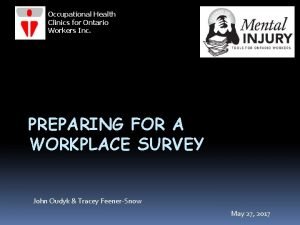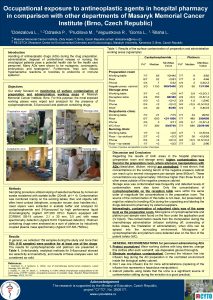Occupational Exposure to Antineoplastic Agents of Pharmacy Workers


- Slides: 2


Occupational Exposure to Antineoplastic Agents of Pharmacy Workers in Hospital n n Antineoplastic agents are widely used in hospitals for cancer treatment. Several epidemiological studies found that exposure to antineoplastic agents were associated with reproductive toxic effects, higher rates of advance micronuclei (MN) and sisterchromatic-exchange (SCE), spontaneous abortion, as well as acute allergic reactions. There are thousands of health care workers involving in chemotherapy in Taiwan, but few studies have been conducted to examine the potential health risk related to the use of antineoplastic agents. One medical center and two area hospitals in Taipei, Taiwan were selected to monitor antineoplastic agent levels and to collect exposure background of hospital workers. Surface wipe samples were collected in the pharmacy units and in their adjacent offices in each study hospital. We examined the concentrations of two commonly used antineoplastic agents, 5 Fluorouracil (5 FU) and Cisplatin, in wipe samples and in the disposable protective equipments used in pharmacy units. A self -administered questionnaire was used to collect demographic data, working practices, medical and contact history, and perceived work-related symptoms of staff working in pharmacy units. According to our results, antineoplastic agents were recovered in all of the sampling pharmacy units, including both inside and outside of the administration rooms (inside: 5 FU: N. D. ~934. 62 pg/cm 2, Cisplatin: N. D. ~24. 93 pg/cm 2; outside: 5 FU: N. D. ~825. 75 pg/cm 2, Cisplatin: N. D. ~55. 46 pg/cm 2). We detected antineoplastic agents not only on outer gloves (5 FU: N. D. ~2. 87× 106 pg/gloves, Cisplatin: N. D. ~1. 02× 105 pg/gloves), but also on some of the inner gloves (333 pg/gloves). Among the 81 study pharmacy workers, 40% have been exposed to antineoplastic agents. Half of them suspected that the agents leaked during drug preparation. Although gloves and gown must be worn at all time while handling drug in all of the study hospitals, eye protection, mask, and hair cot were not required. Most subjects recognized the potential exposure to antineoplastic agents through inhalation and dermal contact, but not through ingestion. However, we did detect antineoplastic agents on office tables, indicating potential exposure through contaminated hands or food. In light of extensive antineoplastic agent contamination in pharmacy units, the study hospitals applied improved precaution practices, which resulted in better contamination control. Therefore, better control regulations and procedures should be implemented in hospital pharmacy units to minimize workers’ exposure and health risk.



